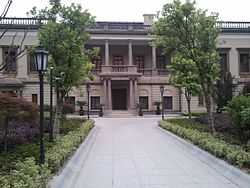British Supreme Court for China
| His Britannic Majesty's Supreme Court for China | |
|---|---|
|
British Supreme Court for China Building, Shanghai | |
| Established | 1865 |
| Dissolved | 1943 |
| Country |
China (1865-1943) Japan (1865-1899) Korea (1884-1910) |
| Location |
No. 33, The Bund Shanghai International Settlement |
| Authorized by | British extraterritorial jurisdiction |
| Decisions are appealed to | Judicial Committee of the Privy Council |
The British Supreme Court for China (formally His Britannic Majesty's Supreme Court for China) was a court established in the Shanghai International Settlement to try cases against British subjects in China under the principles of extraterritoriality.
The court also heard appeals from consular courts in China, Japan and Korea and from the British Court for Japan which was established in 1879.[1]
History of the Court
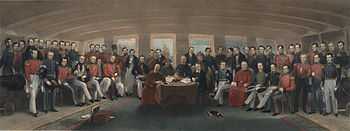
Britain had acquired extraterritorial rights in China under the Treaty of Nanking in 1842. The United States obtained further extraterritorial rights under the Treaty of Wanghsia which Britain was able to take advantage of under the Most Favoured Nation provision in a Supplemental Agreement to the Treaty of Nanking. Subsequently, under the Treaty of Tientsin [2] these rights were provided for directly in a Sino-British Treaty. In 1858, Britain obtained extraterritorial rights in Japan under the Anglo-Japanese Treaty of Amity and Commerce.
The Treaty of Tientsin specified how such jurisdiction was to be governed:
- Disputes between British subjects would "be subject to the jurisdiction of the British authorities."[3]
- For criminal acts, Chinese subjects would be arrested and punished by the Chinese authorities, according to Chinese law. In similar fashion, British subjects tried and punished by the Consul, "or other public functionary authorized thereto," according to British law.[4]
- Where a British subject wished to lodge a complaint against a Chinese subject, or vice versa, it had to be presented to the British consul, who would "do his utmost to arrange it amicably." Failing that, "he shall request the assistance of the Chinese authorities, that they may together examine into the merits of the case, and decide it equitably."[5]
- In civil matters, Chinese authorities would enforce debts owed by Chinese subjects to British subjects, and British authorities would do likewise for those owed by British subjects to Chinese subjects.[6]
Jurisdiction in the first instance, as well as in matters involving British defendants, was vested in the British consular courts, while in the Shanghai International Settlement matters relating to criminal acts and debt enforcement involving Chinese defendants were vested in a "Mixed Court" (Yangjingbang lishi gongxie,[7] later known as Huishen gongxie).[8] Matters relating to complaints were not considered to be judicial.[7]
Appeals from British consular courts initially went to the Supreme Court of Hong Kong, which gradually became unpopular as British economic activity rose in the Yangtse valley.[9] The establishment of the British Supreme Court for China and Japan[lower-alpha 1][10] was not challenged from any official quarter in China, as it was seen to be not only a way to more efficiently try matters close to the scene, but also to allow Qing officials to exert direct pressure on British authorities when they were not satisfied with a sentence.[9]
In 1879, reflecting the growing British commercial interests in Japan and the inconvenience of bringing a first instance action in Shanghai, the British Court for Japan was established in Kanagawa (now part of Yokohama) with first instance jurisdiction in Japan.[11] The Court for Japan also heard appeals from consular courts in Japan. Appeals from the Court for Japan were heard by the Chief Justice and Judge of the Supreme Court in Shanghai.
The United Kingdom later obtained extraterritoriality in Korea as a result of the United Kingdom–Korea Treaty of 1883. The court's jurisdiction was subsequently extended there in 1884, but the court's name remained unchanged.[12]
Under the terms of the Anglo-Japanese Treaty of Commerce and Navigation of 1894, Britain gave up extraterritorial rights in Japan with effect from July 1899.[13] The court was renamed the British Supreme Court for China and Corea in 1900.[lower-alpha 2][14] The Court for Japan officially heard its last case, which had been filed before the end of July 1899, in early 1900.
Under the Japan-Korea Treaty of 1910, Korea was annexed by Japan and Britain automatically lost extraterritorial rights in Korea. The court was, in January 1911, renamed the "British Supreme Court for China".[15]
In the 1920s there were negotiations with China to give up extraterritorial rights. In 1930 and 1931, after the Kuomingtang consolidated their rule in China, Britain reached an agreement in principle with the Chinese Foreign Minister to give up extraterritorial rights. The Japanese invasion of Manchuria in 1931 and then Northern China in 1937 put the issue on the backburner. The Court effectively ceased to function on 8 December 1941 when the Japanese Navy occupied the court premises at the start of the Pacific War. After 9 months internship, either at home or in the Cathay Hotel (now the Peace Hotel), the judges and British staff of the court were evacuated to Britain aboard the SS. Narkunda.[16]
It was, however, only in 1943 during World War II that Britain gave up extraterritorial rights in China under the British-Chinese Treaty for the Relinquishment of Extra-Territorial Rights in China [17] signed on 11 January 1943 and which came into force on 20 May 1943.[18] The United States gave up its extraterritorial rights at the same time. The court therefore had had jurisdiction over British subjects in Korea for 27 years; in Japan for 34 years and in China for 78 years when the court was finally dissolved in 1943.
Court buildings
In Shanghai, the court was housed in the British Consulate compound. From 1865 to 1871 cases were heard using the rooms that had been used by the consular court. In 1871 a dedicated court building to stand at the back of the consulate building facing on to Yuanmingyuan Road was opened. In 1913 the building was expanded to add a Police Court (on the ground floor) and a second court (on the first floor) immediately south of the main court room. Rooms of similar size were built to the north for consular offices. The building still stands to this day and can be seen from Yuanmingyuan Road.
In Yokohama, the British Court for Japan sat in the British Consulate building. The building was destroyed in the 1923 Great Kanto Earthquake.
In other cities, when the judges of the court went on circuit to outlying cities they would generally sit in courts in British consulate buildings but on occasions would use other premises where important cases of great public interest were being heard.
Jurisdiction
The Court applied the rules of English law and equity to matters in difference concerning:[19]
- British subjects, or between foreigners and British subjects,
- the administration or control of the property or persons of British subjects,
- the repression or punishment of crimes or offences committed by British subjects, and
- the maintenance of order among British subjects.
By 1904,[20] such jurisdiction had been expanded so that it covered:
- British subjects, including British protected persons,[lower-alpha 3]
- the property and all rights and liabilities of British subjects
- foreigners within prescribed circumstances
- foreigners of States which by treaty had consented to the exercise of British jurisdiction
- British ships, and all persons and property on board, within 100 nautical miles (185 km) of the coast
In China, the Court deferred to the Hong Kong Supreme Court in several respects, relinquishing jurisdiction over cases involving British subjects where the matter in question occurred:
or where an offence was committed on a British ship by a British subject in Hong Kong[25]
The Court could also decide to refer certain criminal cases involving British subjects to the Hong Kong Court, or to the Sessions Court at Mandalay.[26] Referred cases were tried under English law,[22] instead of Hong Kong law or Indian law.
In 1920, that part of China that formed part of the British consular district of Kashgar was withdrawn from the Supreme Court's jurisdiction. From that time onwards to 1943, extraterritorial jurisdiction in that region was exercised by the High Court of the Punjab, and Indian law applied.[27]
Cases

The court tried cases of all descriptions, all the time applying English law in China, Japan and Korea, including murder trials before juries, divorce cases, commercial disputes, trademark and passing off claims, habeas corpus applications and cases of petty theft. Some of its cases have been posted online by Macquarie University.[28] Official case reports can be found in the North China Herald which was also the Supreme Court and Consular Gazette. Cases from other consular courts in Shanghai were also published in the North China Herald.
Some famous cases included:
- a defamation claim brought by Baron von Gumpach against Robert Hart, the Chief Inspector of Chinese Maritime Customs,[29] which ultimately went to the Judicial Committee of the Privy Council;[30]
- the trial in 1908 of Ernest Bethell, proprietor of the Korean Daily News for sedition against the Japanese Government of Korea[31] as well as a defamation claim brought by Bethell, also in 1908, against the North China Herald;
- a habeas corpus application, in 1939, on behalf of 4 Chinese held by British officials in Tianjin but wanted by the Japanese authorities in China for murder;[32] and
- the trial, in 1897, in the British Court for Japan of Edith Carew for the arsenic poisoning of her husband in Yokohama.[33][34]
Judges of the Court
In its 78 years of existence from 1865 to 1943 the court had 15 full-time judges, including the first Chief Judge, Sir Edmund Hornby, Egyptologist Charles Wycliffe Goodwin; Frederick Bourne, a recipient of thanks from the U.S. President for services rendered; an aristocrat, Havilland de Sausmarez for whom the baronetage of the De Sausmarez Baronets was created; and a recipient of a decoration from the King of Siam, Skinner Turner. The judges came from a variety of places, including from England, Wales, Scotland, Ireland, the British Virgin Islands and South Africa.
Throughout its existence the court had two permanent judges at any one time. From 1865 to 1878 and 1905 to 1943 the senior judge was titled Judge and the junior judge's title was Assistant Judge. Between 1878 and 1905 the senior judge was titled Chief Justice and the junior judge's title was Judge.
| Person | Role | |
|---|---|---|
 |
Sir Edmund Grimani Hornby | Judge (1865–1876)[35] |
| Charles Wycliffe Goodwin | Asst Judge (1865–1878)[36] | |
| George French | Judge (1877), Chief Justice (1878-1881)[37] | |
| Robert Anderson Mowat | Judge (1878-1891); also Judge for Japan (1891-1897)[38] | |
 |
Sir Richard Temple Rennie | Chief Justice (1881-1891); also Judge for Japan (1879-1881)[39] |
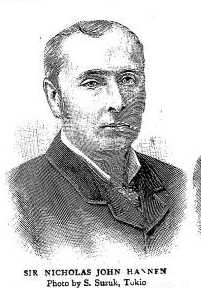 |
Sir Nicholas John Hannen | Chief Justice (1891-1900); also Consul General (1891-1897) and Judge for Japan (1881-1891)[40] |
| George Jamieson, CMG | Judge (1891-1897); also Consul (1891-1897)[41] | |
| Sir Frederick Samuel Augustus Bourne, CMG | Judge (1898-1901); Asst Judge (1901)[42]-1916); Judge of the High Court of Weihaiwei 1903-1916[43] | |
| Sir Hiram Shaw Wilkinson | Chief Justice (1900-1905); also Judge for Japan (1897-1900)[44] | |
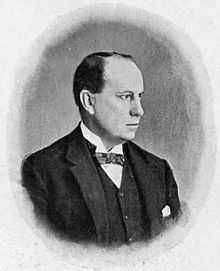 |
Sir Havilland de Sausmarez | Judge (1905-1921); also President of the Full Court of the Supreme Court of Hong Kong (1910-1920)[45] |
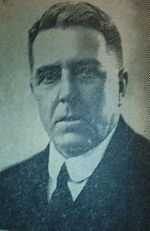 |
Sir Skinner Turner | Asst Judge (1916–1921); Judge (1921-1927)[46] |
 |
Sir Peter Grain | Asst Judge (1921-1927); Judge (1927-1933); also Judge of the High Court of Weihaiwei (1925-1930)[47] |
 |
Gilbert Walter King, OBE | Asst Judge (1927-1931). Registrar of the Court, 1908-1927.[48] |
| Penrhyn Grant Jones, CBE | Asst Judge (1931-1943)[49] | |
 |
Sir Allan George Mossop | Judge (1933-1943)[50] |
Crown Advocates

From 1878, the position of Crown Advocate was created. This was similar to the position of an Attorney General in a colony. The Crown Advocate was not a full-time employee of the Foreign Office but received payment for acting as Crown Advocate. The Crown Advocate was allowed to accept cases from private clients that did not conflict with his role as Crown Advocate. The 6 gentlemen who served as Crown Advocate were:
- Nicholas John Hannen (1878-1881)
- Hiram Shaw Wilkinson (1882-1897)
- Hiram Parkes Wilkinson (1897-1925) (also Judge of the British High Court of Weihaiwei (1916-1925))
- Allan George Mossop (1925-1933)
- Victor Priestwood (1934-1939)
- John McNeill (1939-1942)
Hiram Parkes Wilkinson was the son of Hiram Shaw Wilkinson. Together they served as Crown Advocate for a total of 44 years.
Further reading
- Cassel, Pär Kristoffer (2012). Grounds of Judgment: Extraterritoriality and Imperial Power in Nineteenth-Century China and Japan. Oxford University Press. ISBN 978-0-19-979205-4.
- Clark, Douglas (15 February 2012). "Hong Kong's Judicial Gunboats". LexisNexis.
Notes
- ↑ formally "Her Britannic Majesty's Supreme Court for China and Japan"
- ↑ formally "Her Britannic Majesty's Supreme Court for China and Corea" (1900-1901) and, later, "His Britannic Majesty's Supreme Court for China and Corea" (1901-1910)
- ↑ which was the subject of a 1914 appeal to the Judicial Committee of the Privy Council.[21]
References
- ↑ "Supreme Court of China and Japan, establishment". The North China Herald (Shanghai). 29 July 1865.
- ↑
 Treaty of Tien-Tsin between the Queen of Great Britain and the Emperor of China. Wikisource. 1858., ratified in 1860
Treaty of Tien-Tsin between the Queen of Great Britain and the Emperor of China. Wikisource. 1858., ratified in 1860 - ↑ Treaty of Tientsin, art. XV
- ↑ Treaty of Tientsin, art. XVI
- ↑ Treaty of Tientsin, art. XVII
- ↑ Treaty of Tientsin, art. XXII
- ↑ 7.0 7.1 Cassel 2012, p. 67.
- ↑ Cassel 2012, p. 72.
- ↑ 9.0 9.1 Cassel 2012, p. 68.
- ↑ The China and Japan Order in Council, 1865, The London Gazette: no. 22963. pp. 2240–2255. 28 April 1865.
- ↑ The China and Japan Order in Council, 1878, The London Gazette: no. 26416. pp. 4767–4769. 23 August 1878.
- ↑ China, Japan, and Corea Order in Council, 1884, The London Gazette: no. 25372. pp. 2991–2993. 1 July 1884., as amended by the China, Japan, and Corea Order in Council, 1886, The London Gazette: no. 25575. pp. 1655–1656. 6 April 1886.
- ↑ The London Gazette: no. 27127. pp. 6234–6235. 17 October 1899.
- ↑ The China and Corea (Supreme Court) Order in Council, 1900, The London Gazette: no. 27172. p. 1618. 9 March 1900.
- ↑ The Corea Order in Council, 1911, The London Gazette: no. 28460. p. 688. 27 January 1911.
- ↑ Report from Allan Mossop, Judge, to the Secretary of State of Foreign Affairs, dated 24 September 1942 FO369/2719
- ↑ "Treaty for the Relinquishment of Extra-Territorial Rights in China and the Regulation of Related Matters (Cmd. 6456)" (PDF). Foreign and Commonwealth Office. 11 January 1943.
- ↑ The China Order in Council, 1943, The London Gazette: no. 36029. pp. 2331–2332. 25 May 1943.
- ↑ The China and Japan Order in Council, 1865, ss. 4-5
- ↑ The China and Corea Order in Council, 1904, The London Gazette: no. 27728. pp. 6887–6909. 28 October 1904.
- ↑ Ibrahim v. The King [1914] UKPC 1, [1914] AC 599 (6 March 1914), P.C. (on appeal from Hong Kong)
- ↑ 22.0 22.1 22.2 Clark 2012.
- ↑ The Wei-hai-wei Order in Council, 1901, The London Gazette: no. 27338. pp. 4929–4939. 26 July 1901.
- ↑ The Wei-hai-wei Order in Council, 1930, The London Gazette: no. 33683. pp. 531–532. 23 January 1931.
- ↑ The China and Corea Order in Council, 1904, s. 81
- ↑ The China and Corea Order in Council, 1904, s. 50
- ↑ The China (Kashgar) Order in Council, 1920, The London Gazette: no. 31821. pp. 3153–3163. 12 March 1920.
- ↑ "Colonial cases: China and Japan". Macquarie University.
- ↑ "von Gumpach v. Hart". 22 March 1870.
- ↑ Hart v Van Gumpach [1873] UKPC 9, (1872) 9 Moo PC NS 241 (28 January 1873), P.C. (on appeal from China and Japan)
- ↑ North China Herald, 27 June 1908 pp825-828
- ↑ The Times, 14 August 1939
- ↑ "Death of Mr. W.R.H. Carew. Inquest. [and proceedings & trial for murder, H.B.M's Court for Japan, 1897]". Japan Gazette. 1897.
- ↑ A book has also been written on this case: Whittington-Egan, Molly. Murder on the Bluff: Carew Poisoning Case. Neil Wilson Publishing. ASIN 189778452X. ISBN 1-89778452-X.
- ↑ Hertslet, Edward (1877). Foreign Office List. London: Harrison. pp. 119–120.
- ↑ Foreign Office List 1878, p103
- ↑ Foreign Office List 1881, p98
- ↑ Foreign Office List 1898, p173
- ↑ Foreign Office List 1892, p180
- ↑ Foreign Office List 1900, p130
- ↑ Foreign Office List 1900, p145
- ↑ The London Gazette: no. 27308. p. 2856. 26 April 1901.
- ↑ Foreign Office List 1917, p209
- ↑ Foreign Office List 1908, p386
- ↑ Foreign Office List 1943, 352
- ↑ Foreign Office List 1928, pp424-425
- ↑ Foreign Office List 1934, p257
- ↑ Foreign Office List 1932, p304
- ↑ Foreign Office List 1943, p232
- ↑ Foreign Office List 1943 p267-8
